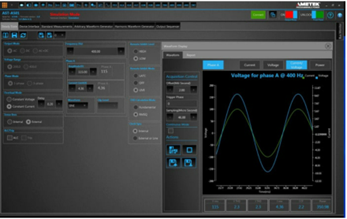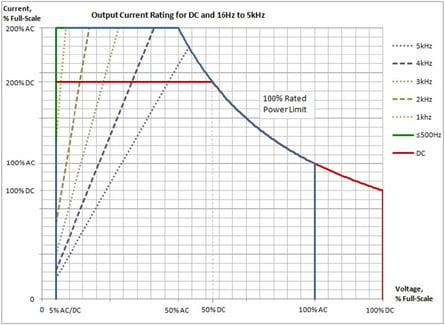Programmable AC sources are evolving as their performance increases, and they add features. If you are in the market for an AC source for the first time in five or ten years, you will notice some significant differences.
As described in the recent white paper “What to Look for When Choosing a Programmable AC Source or DC supply,” modern AC sources offer higher power densities, and they can provide considerable flexibility in power, current, and voltage ratings, helping you future-proof your test systems to meet changing requirements.
Power density is a key factor to consider if you are looking for an AC source and want to put it in a rack. In addition, applications are emerging for very high-power AC sources. High-power models have regenerative and electronic-load capabilities in many applications, including renewable-energy tests. Modern sources offer emulation capabilities that mimic the legacy sources’ operation to smooth the transition from legacy sources.
Energy-density improvements highlight AC sources
Exemplifying the features now available on AC sources is the California Instruments Asterion AC product lineup. Versions are available in 1U, 2U, 4U, and 14U chassis, offering output ratings from 500 VA to 18,000 VA; 14U versions can be paralleled for 36,000 VA.
A 4U version, the Model AST6003, demonstrates the improved power density of the new sources. It delivers 6,000 VA, compared to the 5,500 VA provided by a legacy source in an 8.71-in.-high (equivalent to 5U) configuration. A quick calculation shows that the AST6003 delivers a power density of 1,500 VA per rack unit vs. 1,100 VA per rack unit for the legacy source: a 36% improvement. In addition, the AST6003 is available with an optional GPIB interface and emulation capability for the legacy source to simplify your system upgrades and minimize the need to update legacy software. The emulation capability allows AST6003 units to be paralleled up to the legacy source’s maximum rating of 33.3 kVA.
AC sources add voltage and current options
The Asterion AC series also provides flexibility in output current and voltage ratings. It offers AC plus DC outputs with low and high voltage ranges of 200 or 400 VAC and 250 or 500 VDC. The 2U, 4U and 14U versions can generate single- or three-phase outputs. You can control all versions from the front panel or remotely using AMETEK Programmable Power’s Virtual Panels graphical user interface (Figure 1).

Figure 1. Asterion AC sources work with the Virtual Panels user interface.
Output current flexibility is also essential, and the Asterion AC series employs AMETEK Programmable Power’s iX2 constant-power capability that allows current to increase as output voltage decreases. As shown in Figure 2, 100% power remains available as the output voltage rolls down from 100% rated voltage to 50% rated voltage, with the current rising from the 100% full-voltage rating to 200%, resulting in a constant-power output characteristic until reaching a plateau at the 200% current level. Note from the figure that the plateau does vary based on the output frequency.

Figure 2. The Asterion AC source exhibits a constant-power output characteristic.
AC source power ratings explode
One trend in programmable AC sources is the increasing demand for higher power ratings. Just a decade ago, 5- to 10-kVA was considered high power. Today, requirements for half a million VA are common, driven partly by the need to test grid-scale renewable-energy equipment. AMETEK Programmable Power’s entries in the high-power AC-source range include the California Instruments Sequoia, a full four-quadrant AC source with electronic-load capability, and Tahoe, an economical two-quadrant option for customers not needing four-quadrant operation. Both employ silicon-carbide (SiC) devices to boost switching speeds and improve efficiency.
Both the Sequoia and Tahoe sources come in three form factors: 15 kVA, 22/30/45 kVA, and 90 kVA, all of which can deliver the same power rating in DC mode. The design is flexible, and power ranges above 1.08 MVA are available. The units scale up easily—as many as six 22/30/45-kVA chassis can be connected in parallel up to a maximum of 270kVA. Twelve 90-kVA units can be connected in parallel for a 1.08-MVA maximum rating. Both Sequoia and Tahoe feature 500-µs time resolution for transients. Regenerative versions conform to anti-islanding requirements.
The Sequoia and Tahoe series offer dual-range 0- to 166-V and 0- to 333-V line-to-neutral direct-coupled outputs, corresponding to 287 VAC and 576 VAC line-to-line. An optional output transformer enables higher voltages for use in AC mode only. Custom versions are also available, including higher-power versions with ratings of more than 1.08 MVA.
Reliability plus flexibility
Finally, AMETEK Programmable Power offers a five-year standard warranty on most of its power supplies, designed to be in service 20 years or more. The company’s sales, service and support teams stand ready to help whether you buy a source for a new application or upgrade a legacy system. For more information, check out our white paper covering modern AC sources and DC supplies. Or, visit our website and contact us today.




